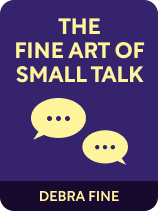

This article is an excerpt from the Shortform book guide to "The Fine Art of Small Talk" by Debra Fine. Shortform has the world's best summaries and analyses of books you should be reading.
Like this article? Sign up for a free trial here .
Do you want to know how to be good at small talk? Should you wait for somebody to approach you or should you start the conversation?
In her book The Fine Art of Small Talk, author Debra Fine says that anyone can master small talk if they practice the principles. Whether you like it or not, it’s impossible to avoid small talk because it’s present in many aspects of life, so you might as well get better at it.
Here are Fine’s tips for how to improve your small talk skills.
Improve Your Small Talk
Clearly, small talk is a valuable tool—but what if it doesn’t come naturally to you? The good news, according to Debra Fine in The Fine Art of Small Talk, is that anyone can learn how to be good at small talk; it’s just a matter of practice and mindset.
(Shortform note: When you want to learn or improve, your mindset—as Fine notes—affects how successful you can be. In particular, you’ll want to adopt a “growth mindset,” rather than a “fixed mindset.” When you hold a growth mindset, you remain open to improvement: You accept the belief that there’s no limit to how far learning and practice will take you. In contrast, those with a fixed mindset believe they’re limited to the traits, intelligence, and potential they were born with.)
According to Fine, taking the following principles to heart as you practice small talk will give you the best chance of improving:
The 3 Small Talk Principles
1. If you want something, Fine says, go get it. If your goal is to meet new people, don’t just stand around alone or talk to people you already know. Instead, actively approach strangers.
(Shortform note: Why is being proactive so important? Stephen Covey, author of The 7 Habits of Highly Effective People, explains it’s because initiative is key to adopting new behaviors—it’s how we exert control over our circumstances. Covey might say that if you’re bad at small talk, it’s time to stop just letting small talk happen to you. Instead, accept that you’re having trouble, take responsibility for improving, and actively make an effort to change.)
2. According to Fine, it’s your job to start the conversation. The second most common fear in America is of starting conversations, particularly with strangers. Because this fear is so common, you’re unlikely to face rejection if you initiate conversation—in fact, your conversational partner is likely to be relieved that you made the effort.
(Shortform note: Contrary to Fine’s claim, America’s most common fears change year-to-year based on the circumstances we’re dealing with—a fear of conversing with strangers doesn’t usually make the top 10. At the time of The Fine Art’s publication, for example, it was often claimed that Americans’ number one fear was of public speaking, though fears of terrorist attacks sometimes polled higher. In 2021, the most common fears were of political corruption, the death of a loved one, or of a loved one contracting the coronavirus.)
3. It’s as much your job to carry the conversation as it is your partner’s, Fine notes. When you leave the hard work of maintaining conversation to someone else, you selfishly put your comfort ahead of theirs. Conversation is a two-player game, and you need to participate equally.
(Shortform note: Fine’s point that you have to learn to carry your weight echoes a common complaint that she implies, but doesn’t openly state: that too many people refuse to hold up their end of a conversation. If you want to be a better conversationalist, you must be willing to take charge and set the direction. Aim to do so multiple times in every encounter, to ensure you’re practicing this skill.)
| Strangers Aren’t the Only Use-Case for Conversation-Starting Skills You may think small talk is mainly for getting to know strangers whom you don’t know well enough to engage in deep conversation. However, it can benefit you in many other situations, too. You can use it to: – Reignite a conversation that’s been interrupted or broken off – Reconnect with old friends or people you haven’t spoken to in a while – Advance a casual friendship to a deeper connection, or salvage one that’s fading away – Connect with friends of friends whose social circle you’d like to be a part of – Bring life and excitement to a gathering that’s become aimless or dull – Show those around you what’s interesting and valuable about having you around |

———End of Preview———
Like what you just read? Read the rest of the world's best book summary and analysis of Debra Fine's "The Fine Art of Small Talk" at Shortform .
Here's what you'll find in our full The Fine Art of Small Talk summary :
- Why we need small talk and why we shouldn't avoid it
- How to appear confident and engaging in any context
- How to break the ice with strangers and keep the conversation going






